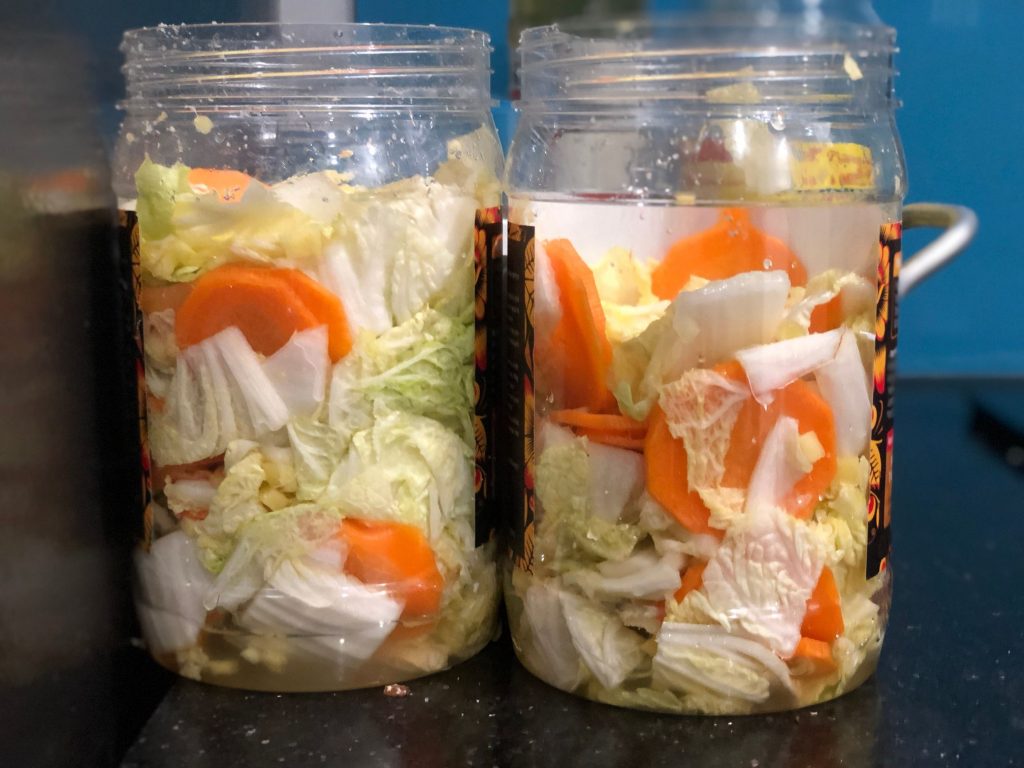Vietnamese kimchi, known as “củ cải bắp” or “củ kiệu,” is a type of fermented vegetable dish in Vietnamese cuisine. It’s typically made with pickled mustard greens or cabbage, and it often includes ingredients like garlic, ginger, chili, and sometimes daikon radish.
The main difference between Vietnamese kimchi and Korean kimchi lies in the ingredients and flavor profiles. While both are fermented vegetable dishes, they use different vegetables and seasonings.
Korean kimchi, the more widely known variety, is often made with napa cabbage and Korean radishes. The seasoning includes garlic, ginger, Korean red pepper flakes (gochugaru), fish sauce, and sometimes other ingredients. The result is a tangy, spicy, and flavorful dish that is a staple in Korean cuisine.
The vegetables are typically salted and left to ferment. The fermentation process develops the unique flavors of the dish while preserving the vegetables. The time required for fermentation can vary, affecting the taste and texture of the final product.
Vietnamese kimchi is often served as a side dish, adding a flavorful and fermented element to a meal. It can also be used as an ingredient in various Vietnamese dishes, providing a tangy and spicy kick. While not as globally renowned as Korean kimchi, Vietnamese kimchi holds cultural significance in Vietnamese cuisine. It reflects the use of fermentation and pickling techniques in Vietnamese culinary traditions.
It’s important to note that variations may exist in the preparation of Vietnamese kimchi, as recipes can vary across regions and individual preferences.
Vietnamese Kimchi
This is a very simple recipe that we have from a local restaurant. Vietnamese kimchi normally is not as spicy as the Korean one. It is often added in a separate small dish to most meat meals we ordered in small local restaurants.
Kimchi is high in fiber, vitamins A, B1, B2, B12, calcium and iron and it is low in calories.
Ingredients:
Optional
Instructions
-
Cut cabbage into bite-size squares, slice carrot and cut spring onions into 4-5cm long parts.
-
Put all cut vegetables into a large bowl add salt and water to cover it. Leave in room temperature for 1 hour.
-
In the meantime grate garlic and finely cut the ginger. Put both in a bowl, add sugar, vinegar, fish sauce and optionally paprika and chilli flakes. Mix well.
-
Move your cabbage to a large strainer and rinse it well with fresh water to remove the excess of salt.
-
Place vegetables in the bowl with garlic and ginger and mix it all very well.
-
Leave it in room temperature for a day. Put it all in a container or a jar and keep in the fridge. It should be ready to eat the following day and can stay in the fridge for a long time. The longer the more intensive taste it will have.
Nutrition Facts
Servings 4
- Amount Per Serving
- Calories 95.6kcal
- % Daily Value *
- Total Fat 1.2g2%
- Sodium 2206mg92%
- Potassium 238mg7%
- Total Carbohydrate 19.7g7%
- Dietary Fiber 2.4g10%
- Protein 3.2g7%
- Vitamin A 45 IU
- Vitamin C 21 mg
- Calcium 5 mg
- Iron 12 mg
- Vitamin E 7 IU
- Vitamin K 26 mcg
- Niacin 9 mg
- Vitamin B6 13 mg
- Phosphorus 6 mg
- Magnesium 9 mg
* Percent Daily Values are based on a 2,000 calorie diet. Your daily value may be higher or lower depending on your calorie needs.


Leave a Reply